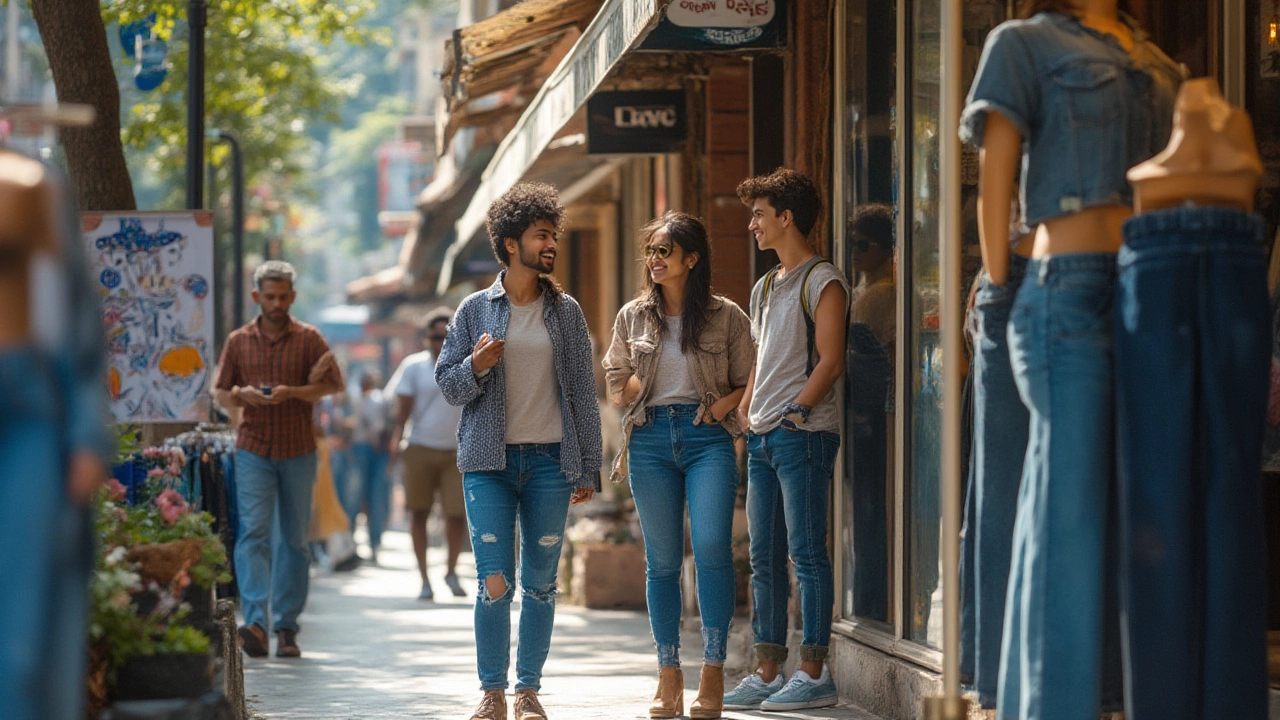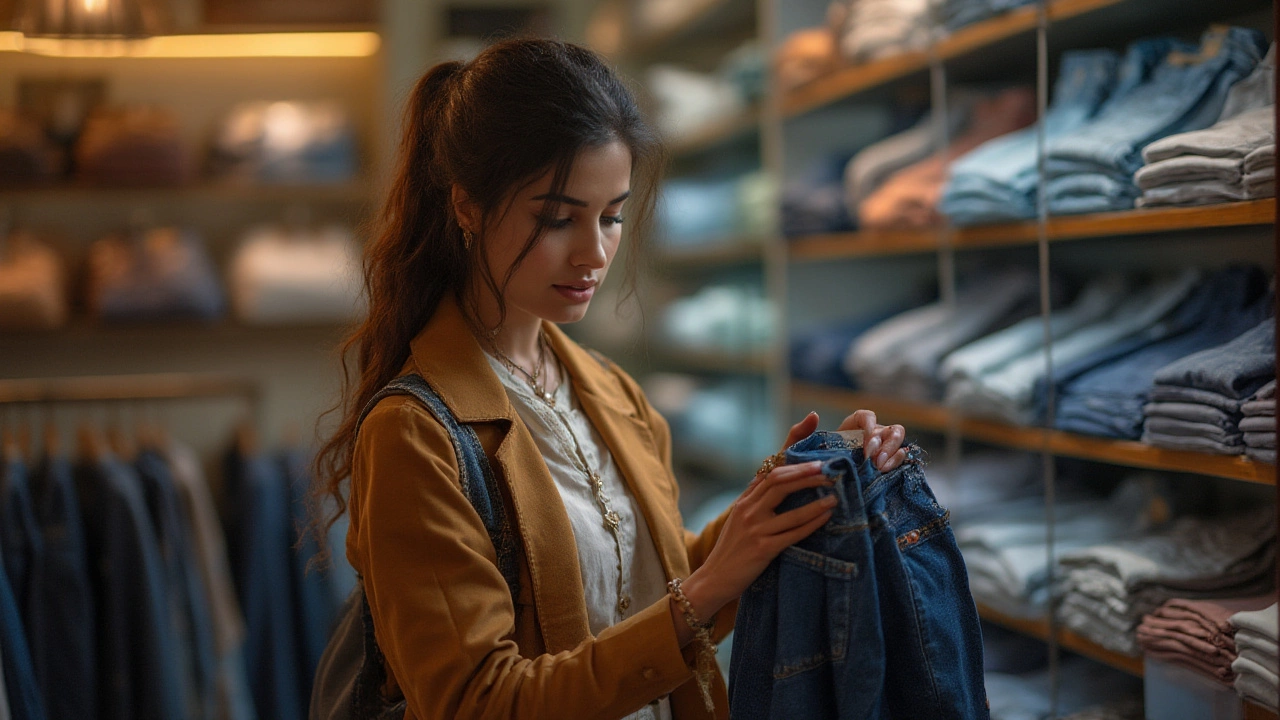Best Jeans Brands for Quality and Style in 2025

Denim isn’t just a fabric—it’s really closer to a personal companion. Zip, button, and suddenly you’ve got confidence on your hips. But ever buy a new pair of jeans, then, a month in, catch a glimpse of tiny tears at the seams? Or watch color fade before you’ve even washed them? Yikes. Not all denim’s created equal. In 2025, jeans choices can be overwhelming, and brands love to shout about their stretch technology or eco-credentials. So, who actually sells good quality jeans that won’t let you down after one summer?
The Science (and Secrets) Behind Durable Denim
If you’ve ever wondered why some jeans age gracefully and others fray, it’s not by accident. The secret sauce isn’t just about the brand name—it's about cotton source, weave pattern, dye method, and what happens in the sewing room. Real quality jeans often begin with high-grade cotton. Selvedge denim, for example, is woven on old-school shuttle looms and actually has a tighter, denser edge, making it more durable. Japanese denim specialists like Uniqlo U or Edwin have made a reputation because of this—and yes, they really do feel different. If you see "12oz" or "14oz" weights, these numbers tell you how thick and sturdy the fabric is. Basic fact: sturdy jeans usually clock in above 12oz (for heavy-duty feel), while lighter weights give more stretch but might not last as long.
Here’s a lesser-known tip: jeans stitched with chain-stitch hems tend to resist fraying way better than lock-stitch ones. Many premium jeans brands won’t skimp on these little details. Another thing? If your jeans feel stiff out of the box, that’s usually good—raw or rigid denim softens over time and shapes to your body. A soft, floppy feel might seem cozy at first, but it’s likely treated so much in the factory that it’s lost strength. Brands touting "ring-spun" or "open-end spun" yarn—ring-spun is smoother, lasts longer, and is pricier to make. Selvedge edges and these ring-spun cottons? Denim nerd gold.
Look at the label. If it says 100% cotton, that’s probably going to last longer—but there’s a catch. A tiny percentage of elastane (2% or less) can make jeans comfortable without killing the structure. Some new breakthroughs even use recycled materials or organic blends, with Patagonia and Nudie Jeans leading eco-conscious efforts. Check care labels too—some require gentle treatment to extend lifespan. Good brands share repair tips or even offer repair programs (shout out to Nudie’s free repairs, which is awesome for both you and your jeans).
| Feature | Impact on Quality | Brands Noted For This |
|---|---|---|
| Selvedge Denim | Higher durability, keeps shape | Edwin, Uniqlo U, Levi's Vintage |
| Chain-stitch Hems | Better resistance to wear/tear | Levi's, Nudie Jeans |
| Heavyweight (14oz+) | Longer lifespan, richer texture | Iron Heart, Samurai Jeans |
| Organic/Recycled Cotton | Eco-friendly, gentle for skin | Patagonia, Nudie Jeans |
Stitching, hardware (rivets, zippers), and even pockets are parts of the quality equation. Cheap jeans? Thin pocket linings and plastic zippers. Quality ones? Steel or copper rivets and zippers from brands like YKK. So, next time, touch, turn inside out, and squint at those seams. Your jeans will thank you years down the road.
The Most Popular Brands for High-Quality Jeans in 2025
Let’s cut through the noise and talk real brands. These are the names popping up in closets of people who actually live in their jeans, not just influencers on glossy feeds.
- Levi’s: The granddaddy of them all. The 501 is practically denim royalty. In 2025, Levi’s doesn’t just dial up tradition—they blend modern fits (hello, Ribcage and Wedgie) with sustainable lines like Water
- Nudie Jeans: If you want jeans that look good, wear in beautifully and come with a strong green story, Nudie delivers. They use organic cotton, offer free lifetime repairs, and publish every detail of their production chain. Their jeans have won the hearts of vintage lovers, eco-warriors, and skinny-jeans addicts alike.
- Uniqlo: Think basic done right and on budget. Their Uniqlo U line, directed by Christophe Lemaire, has especially impressed denim fans who want selvedge without 200-dollar price tags.
- APC: Parisian cool with Japanese denim. These raw, minimalist jeans are the starter pack for "I want to grow my own fade patterns." They feel stiff at first, break in perfectly, and hold together for years. Great for anyone tired of trendy rips.
- Levi’s Vintage Clothing: LVC recreates old classics, using painstaking details like chain-stitching and heavyweight denim. Pricey, but they’re heirlooms.
- Everlane: Transparency is their thing. You can see what your jeans cost them to make, and if you’re after ethical production, you can’t go wrong with their denim lineup. Modern fits too.
- Iron Heart: If you crave heavy, nearly indestructible denim (some of their jeans come in 21oz fabric), Iron Heart rules. Made in Japan, for legit denim fanatics.
- AG Jeans: Softness that surprises. AG mixes luxury with technology—soft touch, solid stitching, and a tailored look, all without saggy knees.
- Madewell: Fantastic for women’s fits—high-rise, petite, curvy, tall—Madewell’s denim feels built to move with you, holds up against repeated washing, and doesn’t cost a fortune. Their recycled cotton program is a bonus.
- Levi’s Made & Crafted: A notch above classic Levi's. High-end fabrics, luxe details, and trend-aware shapes for picky denim lovers.
- Edwin: Legendary for selvedge and heavy denims, especially in Europe and Japan. Fades beautifully, and the Japanese lines showcase meticulous quality.
- Wrangler: Still a staple for rugged workwear and straight-up durability. Their Cowboy Cut and Premium Performance collections leave cheap jeans in the dust.
- Patagonia: For the greenest possible jeans, Patagonia uses organic cotton and guarantees fair labor practices. Fade nicely, wash well, and are built to outlast trends.
- Samurai Jeans: Want something truly traditional and tough? Samurai Denim is obsessed with heritage Japanese selvedge—definitely a splurge, but made for the collector who wants something different.
- Naked & Famous: Wildly creative. Every season they drop limited run fabrics—think glow-in-the-dark, super heavyweight, or rainbow selvedge. If you want storytelling in your jeans, this is it.
Pick your brand by your budget, style, and priorities: eco-friendliness, heritage, innovation, or fit. But don’t fall for just a fancy label. Top jeans brands put their money in materials and craft—not just marketing.

How to Spot High-Quality Jeans When Shopping
Here’s the thing: good jeans are a savvy mix of touch, fit, and finish. And yes, you can totally spot them, even if you’re standing in a fluorescent-lit chain store. Grab a pair and do a squeeze test on the fabric. It should feel dense, not limp or papery. If the denim springs back when you pull it, that tension is a sign of solid weave. Flip the hem—look for thick, neat stitching, and if you see a colored stripe (like red or white) running along the inside edge, congrats, that’s selvedge.
Quality jeans have neat, even stitches—no loops, skipped spots, or wispy edges. The best pairs use flat-felled seams, which mean less chafing and way less chance of splitting open when you bend. Zippers? Should move smoothly, and ideally will say “YKK” (reliable, global zipper leader—every denim-head checks for this). Rivets hold high-stress points together, especially around the pockets, and shouldn’t pop off under pressure.
- Tug the pockets—thin cloth tears fast, heavy cotton means you can stuff your phone, keys, snack bars (I do it all the time) without worries.
- For color, deep, even dye is a sign of quality. Cheaper jeans fade or streak after just a few washes. Raw denim fades naturally over time, and that’s the fade you want.
- Smell and feel. If they reek of chemical dye or feel overly soft, they might’ve been blasted with finishers to shortcut the process.
- Size up or down if needed—some jeans stretch out a lot, some shrink. Brands like APC recommend you size down, while others, such as Levi’s, are usually true to size.
- If possible, try them on and do a few high-knee bends in the fitting room. Comfort plus movement makes a pair you’ll actually wear nonstop.
Safety tip: Good jeans don’t have to launch you into debt, but if you can, save up and buy fewer, better pairs. One great pair that fits your style is worth five fast-fashion flops. Treat them right—wash inside out in cold water, skip the dryer, and don’t overwash unless you’re in mud up to your shins. Odor issues? Air them out or pop them in the freezer overnight for a quick refresh (sounds wild but it kills bacteria, not joke!).
Best Brands by Body Type and Personal Style
“Best” can get personal fast. What fits your best friend perfectly could look wonky on you. Some brands “get” curvy bodies, others suit lanky legs, others shine for petites.
- For curvy or hourglass figures, Madewell’s Curvy line and Levi’s Wedgie fit are wildly popular—they nip the waist and don’t gap at the back.
- Pear-shaped or those with muscular thighs can find great fits in Wrangler Cowboy Cut or Everlane’s Athletic Fit jeans.
- Petite shoppers, try Uniqlo, Levi’s 501 cropped, or APC’s Petite Standard for spot-on proportions.
- If you’re after gender-neutral or looser fits, Nudie’s relaxed shapes and Levi’s 501 or 505 are go-tos.
- Love edgy, fashion-forward styles? Naked & Famous, Mother, or Citizens of Humanity drop trend-driven washes and embroidery each season.
- Classic straight-leg fans can always return to Lee 101 or Levi’s 511. Timeless, comfortable, and versatile.
Getting that “wow” moment in the fitting room is part cut, part fabric. If one brand just doesn’t flatter you, try others with a similar cut but different rises or pocket placements. Fun fact: back pocket height and size can really change how your rear looks—smaller, higher-placed pockets make a lift, while bigger, low pockets flatten things out.
Seasonal trends matter too. Loose, baggy fits have made a big comeback (hello, 1990s!), but skinny jeans still have their die-hards. Most brands now offer a dizzying range of fits. If you can, mix and match. You don’t have to pick a side in the skinny vs. baggy debate—rock both, depending on your outfit vibe.

Troubleshooting and Caring for Your Investment Jeans
So, you’ve made the plunge and bought great jeans. Now what? First, don’t overwash—really, unless they’re dirty, jeans love being aired out. Washing too often can break down fibers, so spot clean when possible.
If you’re dealing with color bleed, especially from raw or dark indigo jeans, soak them in cold water with a splash of distilled vinegar to set the dye. Always wash inside out, delicate cycle, cold water, and skip the dryer—heat shrinks cotton and fades dyes. And if you want that perfect “lived-in” look? Wear, repeat, repeat. The best fades only arrive from real life use—walking, biking, dancing the night away (if that’s your thing).
Busted rivets or seams can usually be fixed by a good tailor. Premium brands occasionally offer free repairs; check the label or your receipt. To slow knee blowouts, rotate your pairs and avoid kneeling on rough surfaces a lot.
| Care Task | Why It Matters | How Often |
|---|---|---|
| Washing | Preserves color, reduces fiber breakdown | Every 4-6 wears |
| Spot Cleaning | Keeps jeans fresh without full wash | When needed |
| Hanging or Flat Dry | Prevents shrinkage, preserves shape | After every wash |
| Inspecting for Tears | Early fixes avoid bigger rips | Monthly |
Hack for removing odors? No need for chemical sprays. Coffee grounds (wrap in a thin sock) absorbing scents overnight, or just expose your jeans to sunlight on a nice day—it kills bacteria naturally. For those obsessed with raw denim: the hardest part is the break-in period. First month, expect stiffness and maybe annoying creases; but by month three, you’ll see unique wear patterns that are 100% yours. Every scuff and fade is a badge.
*Don’t* iron your jeans unless you love shiny marks. And if you’re traveling, roll them instead of folding—that keeps creases sharp and saves suitcase space. Finally, when your favorite pair gets too thin, think about upcycling—denim is tough, and pieces make great tote bags, patches, or even machine-washable coasters. Because with the right pair, nobody throws away good jeans—they just find them a new life.